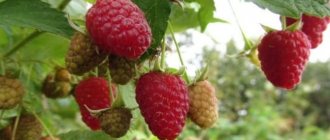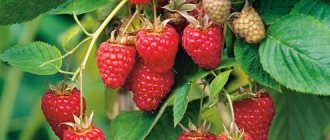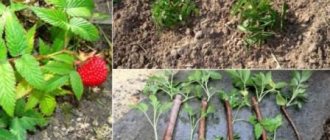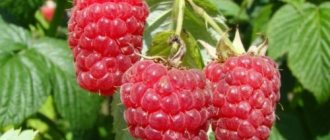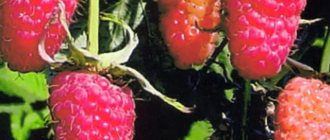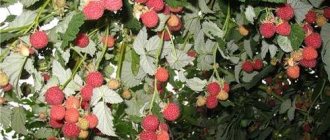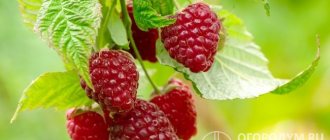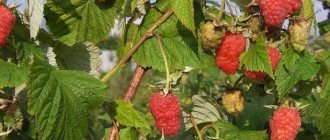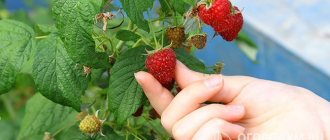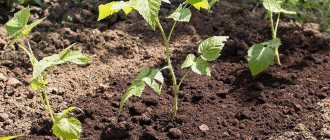Description of the variety
Raspberry bushes are of a tree-like type, belonging to the tall category and reaching 220 cm. The shoot formation of the variety is high, branching is abundant, if all the rules of agricultural technology are followed. The root shoots are quite weak and require very careful handling when transplanting.
You might be interested! A raspberry variety the size of a plum is the Monomakh Cap raspberry.
Brusvyana bears fruit for the first time in June, the second time - from mid-August until frost. The first wave of berries is more abundant. June fruiting of raspberries occurs on shoots of the 2nd year, and August fruiting occurs on young ones that appear in the spring.
The variety begins to bear fruit from the second year after planting, and the harvest during this period is often not very abundant. The plant shows maximum productivity from the third year.
The berries are very large - up to 15 g. Their taste is rich, sweet and sour. The high density of the fruits makes them transportable. The shape of the berries is elongated. The color of the fruits is slightly matte, bright red.
The most common variety is in Russia, Ukraine and Belarus.
Brief description (pros, cons)
Brusvyana raspberries have numerous positive qualities, which primarily attract gardeners.
Advantages of the variety
- yield up to 8 kg. from the bush for 1 season;
- 2 waves of fruiting – in the southern regions a 3rd wave is also possible;
- marketable beautiful appearance of berries;
- rich dessert taste;
- high level of transportability;
- ease of care;
- increased winter hardiness;
- immunity to major raspberry diseases and pests.
In the southern regions, it is also of great importance that Brusvyana raspberries tolerate heat well. At elevated temperatures, its berries do not begin to leak and do not lose their marketable qualities.
The disadvantages of this raspberry rarely outweigh its advantages for anyone, but they are still worth talking about.
Disadvantages of the variety
- the need for a large amount of sunlight - if there is not enough of it, the berries turn out to be very sour;
- weak growth from the roots, which is why it will not be possible to quickly breed the variety;
- strong, pungent, unpleasant odor that comes directly from the bushes;
- presence of acid in taste.
Since there are no raspberry varieties that do not have shortcomings, many gardeners do not take them into account and plant Brusvyana on their plot, if, of course, they like the sour taste.
Diseases and pests, control methods and prevention
The main methods of combating fungal diseases involve the use of chemicals. For Brusvyana raspberries, the following fungicides will be effective: Bordeaux mixture, copper sulfate, Fundazol. For the purpose of prevention, spraying is carried out in early spring. If symptoms of diseases appear, then it is necessary to cut out the diseased, affected areas of the bush.
Insecticides help to escape from harmful insects: Actellik, Decisom, Detoil. You can also protect Brusvyan raspberries from them by performing preventive measures:
- loosening the soil;
- weeding;
- collecting fallen leaves;
- timely watering and fertilizing;
- thinning bushes.
Landing
Plants should be planted with a well-developed root system and a shoot height of no more than 30 cm. The optimal time for planting is mid-April or late September - early October, a period when all metabolic processes are in a slow state and replanting does not cause stress. If you have to plant Brusvyana at another time, then you need to purchase plants with a closed root system.
In the northern regions, planting Brusvyana should only be done in the spring.
Raspberries need slightly acidic, loose and nutritious soil. A site for a raspberry garden needs to be sunny and south-facing. It should not be exposed to drafts.
3 weeks before planting, the area allocated for Brusvyana is dug up. Then holes are dug in the prepared area with a depth of 50 cm and a size of 50x50 centimeters. The distance between bushes should be at least a meter, and between rows from 2.0 meters, which is taken into account when preparing holes. A nutrient mixture of peat, humus and turf soil, taken in equal quantities, is poured into the planting holes.
You might be interested! A popular remontant raspberry variety originally from Russia is the Brilliantovaya raspberry.
The seedlings are planted in pre-prepared holes so that the root collar is flush with the soil surface. You can’t deepen the neck too much! The roots are straightened and covered with earth gradually, in layers, slightly compacting each of them. After planting, the plant is watered.
Agrotechnical features
The specifics of growing the variety are to some extent related to its remontability, but otherwise the main activities in the raspberry field do not differ from traditional ones.
The terrain has a certain significance when choosing a site for planting. In moisture-rich regions of the middle zone, gentle slopes with warm exposures, except those strictly southern, are better suited for raspberries. In the latter case, alternating thaws and frosts in winter can cause damage to plants. In the hot, arid regions of the south, on the contrary, cool slopes are preferred. Well, in any case, you should avoid open hills, from which the wind blows away the snow cover in the cold season, as well as closed basins, where there is stagnation of cold air. Brusvyana has not identified any preferences for soil conditions, and therefore it is recommended to exclude when planting only damp, swampy, excessively acidic and saline areas, as well as places with high groundwater levels.
When preparing the soil for a raspberry tree, it must be freed from the most malicious perennial weeds, and also filled with sufficient doses of organic and mineral fertilizers. In garden plots, fertilizers can be applied directly to the planting holes, mixing them well with the soil. Raspberries are planted in the fall after leaf fall or in the spring at the first opportunity to go into the field. In the latter case, it is advisable to prepare the pits in advance. Tall bushes also require significant living space, and therefore the distance between rows is maintained at least 1.5-2 meters, and between plants in a row 0.7-1 meter.
Caring for fruit-bearing raspberries includes keeping row spacing clean, tying stems to trellises or supports, timely removal of shoots and fruit-bearing biennial shoots, preventive treatments of raspberries against pests and diseases, and, if necessary and possible, regular watering to maintain optimal soil water balance . As a remontant variety, Brusvyana can be completely pruned at soil level in the fall, obtaining especially powerful annual shoots the following year, on which only a late-summer, but very abundant harvest is formed.
Growing and care
Correct agricultural technology when growing Brusvyana raspberries allows you to get a bountiful harvest and powerful, healthy bushes that will overwinter well.
Watering
Brusvyane requires abundant watering, like all other raspberry varieties. The soil should be moist at a depth of 40 cm. Plants need especially a lot of water at the time of flowering and fruiting.
In normal summer conditions, when the temperature does not exceed +27 degrees, watering is carried out once every 10-12 days. In hot weather it will be needed once a week. Each bush requires 30-40 liters of water.
Trimming
Spring pruning is carried out early - before the start of sap flow. Last year's shoots are shortened by 15 cm, and all broken and dry stems are removed. In the fall, after last year's stems have borne fruit, they are cut off completely. It is impossible to leave old shoots for the winter, since they will no longer produce berries, but in the future they will take away the strength from the plant.
Top dressing
The best organic fertilizer for raspberries is rotted horse manure and chicken droppings. They feed Brusvyana from the second year. During the flowering period, it is important to mulch with humus.
Fertilizing with organic matter is carried out in the spring at the beginning of the formation of berries and after fruiting closer to the dormant state. Mineral nitrogen fertilizing is needed only in spring.
Preparing for winter
Frost resistance of Brusvyana raspberries is high, but before the cold season the plant needs to be properly prepared.
All leaves are removed from the bush, and diseased and damaged shoots are also cut off. After this, the soil around the plant is mulched using peat and sawdust. If winter temperatures drop below -25 degrees, then young shoots need to be bent to the ground and covered with spruce branches or non-woven material.
Malina Brusvyana
Register to leave a review. It will take less than 1 minute.
We have 3 different varieties of raspberries in our garden. I consider this one to be the best in terms of yield and taste. We spend the same amount of effort on all varieties, but the return is different for everyone. We live in Pushkino, this variety begins to turn red by mid-June, and by early July the entire crop is fully ripened. Due to the fact that it ripens early for our area, sales are going very well and we are earning decent money. We have made it a rule to apply humus in early spring and apply potassium fertilizers between harvests to increase yields. During the summer and autumn - the variety produces 2 harvests, up to 5 kg per bush. The bushes grow quite tall, up to 2 meters. Trellis are stretched between the rows, all bushes are tied twice - 50 cm from the ground and 120 cm. This variety has a lot of root growth. As soon as we see that one of the bushes is dying, we immediately cut it out, leaving young shoots from the root. Resistance to frost is at the proper level, but for the winter we still sprinkle the raspberries with straw and leaves of fruit trees. The berries are large and the seeds are small. The taste is rich, more sugar than acid. Few are affected by pests.
The variety gives high yield. Dry or rainy summers do not reduce it, only the taste and size of the berries change for the worse. In Crimea, I harvest 3 times a year, so there is no point in freezing/drying, we eat fresh almost all year round. The berries are always large, even gigantic in size. This does not affect the appearance, they are not deformed. All the berries are smooth, beautiful, pleasing to the eye with their power and rich color. Despite their size, the bushes do not bend to the ground; the twigs are strong, strong, and can withstand weight. Up to 30 fruits can ripen on a branch at the same time without bending it. I don’t like making jam from this variety; the berries are hard and don’t boil well. Cook for a long time - all useful microelements will disappear. Cook for 5 minutes, then eat the jam with hard berries. It also requires a lot of sugar, it is sour. I don’t take any special care, raspberries are not capricious. The soil is very ordinary, I rarely fertilize, watering only from rain, the weeds are not bothered. Pests ignore it, only birds peck at it. Every year I thin out the berry patch, otherwise I won’t be able to get through there later. The unpleasant feature is that the bushes have a rather specific smell, I can tolerate it normally, but my husband doesn’t like it.
At the dacha it grows in 2 places. Some bushes are up to 2 meters in height, others up to 2.5. Growth depends on lighting. There are always a lot of shoots growing, so the bushes turn out to be branchy. The shoots are thick, even young ones grow strong and powerful, tending upward without bending. They are not afraid of windy weather, so they do not need tying up. It’s convenient to pick from even branches, the berries always sit thick, but there are thorns, you can’t do without scratches on your hands. I pack in thick clothes with long sleeves. It begins to bear fruit in June, the berries are large, but there are few of them. The main harvest is in August, very long. If the weather permits, it can last up to 100 days. We manage to collect 90% of the ripened fruits before frost. The berries are just as large; this is the largest remontant variety. Our record is 15 grams of berry weight. We collect up to 8 kg from a bush. There is enough not only for preparations, but also for sale. We're driving from the dacha to the city, it's an hour's journey. It keeps well, does not wrinkle, and does not yield juice. But prolonged exposure to heat and sun can spoil the appearance. Optimal storage is in the refrigerator; it can stay there for up to 10 days. Caring for the berry garden is necessary, but it is not annoying and does not require daily effort. Raspberry Brusvyana is water-loving. I water using the drip method. It is difficult to tolerate drought and can reduce fruiting to once.
When purchased from the Vesna nursery, it was promised that the fruits weigh up to 1 gram. In fact, they are only 6-9 grams. The berries are beautiful, of regular shape and have the usual taste - sweet and sour. The yield is 3 kg per bush, although the description of the variety said 7 kg. One could refer to bad weather conditions, but we have a temperate climate in the central district (Kaluga region). I decided to stop further development, the raspberry tree is already 7 years old, I won’t uproot it, but I will also stop careful care. You put in more effort than you get out of it. It is a tree-like bush, branches grow in all directions, not just up. The growth promises exceeded themselves; the bushes grew up to 3 meters, but they should have only grown up to 2 meters. There are few thorns, mainly on the lower part of the rods. Despite the thickness of the shoots and their uprightness, they had to be tied up; the tops of the heads were often broken by the wind. When planting the seedlings, they failed to take this height into account in advance and planted them closer than necessary. Now they are all intertwined with each other. It is better to maintain gaps of 3 meters between rows and 1.5 meters between bushes. Fruits twice. We begin to eat already in mid-June, then in July there is a respite and in August there is new fruiting, the last rare berries arrive before frost. The name is similar to Ukrainian, but the variety is domestic.
I bought it at the market, didn’t expect anything from the variety and didn’t take any special care of it. At the moment, when the bushes are already 3 years old and have grown 2 meters, the care is elementary: I cut off the dried branches, tie them up, water them if there is no rain for a long time. Our winters on the Don are mild, so I don’t wrap the raspberries. Each bush brings about 3 kg, this is not as much as it should be, but I don’t feed it, so I don’t expect more. The harvest in June is scarce, but in August it is abundant. The harvest lasts the whole month: we collect what is ripe, we see a new green ovary, which ripens in a week, etc. The berries are large, slightly sour, firm and store well.
Read also: Marbled pear - characteristics of the variety, pollinators, planting, video
Reproduction
The root shoots of the variety are extremely few in number, and therefore propagation by them is not effective. Propagation is carried out from green cuttings, which can be obtained equally in spring or autumn.
Completely healthy shoots are selected for cuttings. The prepared material is kept in a growth stimulator and planted in wet sand in a greenhouse. After rooting, young raspberries are planted in a permanent place and cared for in the same way as adult bushes.
Reviews
Most reviews about the variety are positive. Gardeners are increasingly choosing this variety of remontant raspberries.
I liked the variety. In my opinion, to get a small raspberry tree, you don’t have to bother with cuttings and limit yourself to a few shoots. The berries taste good, but only if the summer is sunny. If there is not enough sun, then raspberries can only be sent for harvesting, as they grow very sour.
I liked the variety, transportable and with beautiful large berries. I wouldn't call the taste very refined. For fresh consumption, I prefer other sweeter varieties. I grow Brusvyana in parallel with gourmet varieties and send it for harvesting.
The remontant raspberry variety Brusvyana, despite the fact that it is still very young, has already gained popularity. Its unpretentiousness and productivity cannot but attract attention.
Harvesting and storage
Picking raspberries is a painstaking task; you have to pick the berries by hand. The fruits are immediately placed in containers for storage or transportation. The container should be shallow so that the berries do not squash under their own weight. Brusvyana’s berries are dense, you can’t say that they crumple too much, but it’s still not recommended to pour it from one container to another.
If the berries are to be transported, the bottom of the boxes is lined with leaves - for example, raspberry leaves. Layers of berries are also layered with leaves. Store berries in the refrigerator for 5-7 days.
